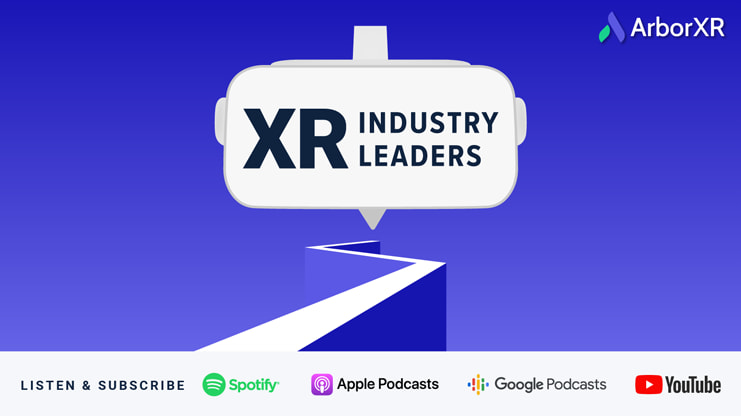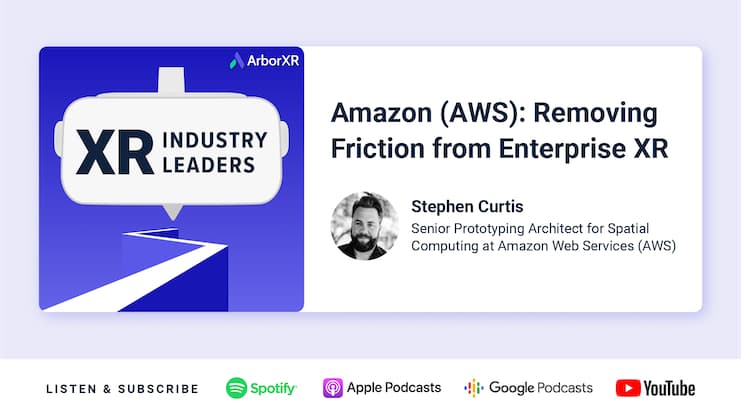
One of the fastest ways to get smart on a new topic is podcasts. And this is certainly the case in the world of XR. Specifically, the XR Industry Leaders podcast offers a worthwhile crash course, including lessons from the front lines of XR implementation in large enterprises.
Produced by ArborXR, the show invites guests representing brands from AWS to UPS to discuss lessons and learnings from launching or executing XR programs. That includes programs for VR training or other ways that XR technologies boost and streamline operations.
Hosted by ArborXR co-founders Brad Scoggin and Will Stackable, guests outline not only XR implementation tactics but broader business strategies. These include everything from how to keep a customer-first mindset to maintaining product focus and knowing when to say “no.”
So to start you on the right foot, we’ve outlined three takeaways from hours of listening. These are a representative sample of the show’s intellectual value, and there’s plenty more where that came from. See them below, including our summary notes and links to the full episodes.
1. Know the Customer
One of the key mantras in product development is reducing friction. But that tends to be all talk unless you actually know what the points of friction are. Where is there friction, and what are all of the possible ways it can creep in? Knowing these nuances is step one.
This has been a key career lesson for Amazon’s Stephen Curtis. As Senior Prototyping Architect for Spatial Computing at AWS, finding and solving product friction is the name of the game. His advice: know the product inside and out… but more importantly, know the customer.
By knowing the customer, you can understand their behavior and how that could align (or clash) with the product. Know every step in their click stream (or other UX interactions). Know their hopes, and dreams, and move into their garage if you have to (not really). It will take lots of rigor.
Listen to the full episode below…
2. Learn When (and How) to Say ‘No’
Focus is one of the most underrated attributes of successful product development. This is true of early-stage companies when resources and runway don’t allow distractions. And it’s true of more mature companies whose ample resources tend to invite those same distractions.
So the name of the game according to Futurus CEO Annie Eaton is to learn when to say “no.” There will be several diverging interests pulling decision-makers in unproductive directions. Be nimble with changing conditions, but stay true to the broader product goals and company mission.
Beyond knowing when to say no, good leaders know how. The magic is in doing it gracefully while motivating and empowering people towards a shared vision, and not alienating them. It’s not about pleasing everyone, but it’s important to treat everyone with respect and dignity.
Listen to the full episode below…
3. Avoid the ‘Magic Glow Effect”
One of XR’s biggest challenges is deployment and implementation. It can have a strong upfront selling proposition, but rolling it out within larger organizations is beset with pitfalls. These include stakeholder buy-in, IT resistance, and other hurdles that lead to the dreaded “pilot purgatory.”
According to UPS Head of Immersive Technology Mark Grob, you can avoid some of these challenges if you pre-empt and sidestep the “magic glow effect.” This is all about managing expectations and avoiding the magnetic pull towards shiny new things, as that novelty wears off.
XR is especially prone to this because it’s shiny and new. But such affinities aren’t sustainable during the implementation rigor to come. So you can set XR up to succeed in any organization with proper expectation setting, thoughtful deployment strategies, and upfront communication.
Listen to the full episode below…
So there you have it… For more on XR Industry leaders, including links to subscribe on your favorite podcast network, see the show’s landing page. Enjoy…





